||| EARTHRISE BY JAY KIMBALL |||
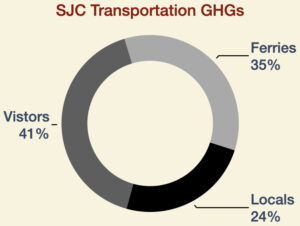 By far, the most significant chunk of local direct greenhouse gas emissions (GHGs) in San Juan County come from transportation – about 78%. County transportation emissions primarily come from local/resident driving, visitor driving, and ferry diesel emissions. (see chart at right)
By far, the most significant chunk of local direct greenhouse gas emissions (GHGs) in San Juan County come from transportation – about 78%. County transportation emissions primarily come from local/resident driving, visitor driving, and ferry diesel emissions. (see chart at right)
The goal is to cut GHG emissions roughly in half by 2030 and net-zero by 2050 while ensuring there are affordable mobility options for all. Looking at similar-sized island communities can help us consider transportation best practices and options for providing clean, affordable transportation here.
Transportation in other island communities
The table below summarizes standard transportation options for Martha’s Vineyard, Nantucket, Mount Desert Island, Salt Spring, and Bainbridge, compared to San Juan County.
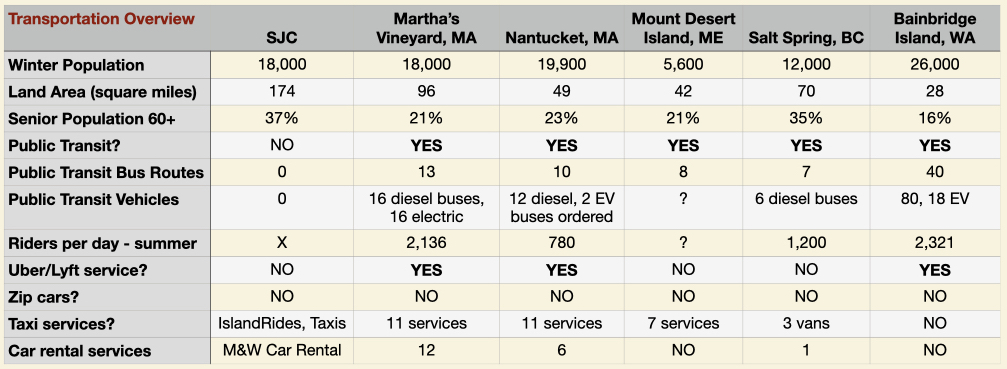
San Juan County has the largest land area spread across multiple islands. Each island has its own transportation needs and mobility lifestyle. There’s likely no single “one size fits all” clean transportation solution that will serve our multi-island geography. The county also has the largest senior population, which can increase the need for senior-friendly transportation services to support aging in place. Some senior centers in the county provide a mix of transportation services to the senior community, within the island, and occasionally to the mainland.
Some other takeaways from the data above:
- Public transit is available and substantial in all but San Juan County. Martha’s Vineyard has the most extensive system, with 13 routes served by 32 buses, 16 of which are electric. All public transit services are transitioning to electric buses and shuttles as fast as possible, funded by state and federal clean transportation grants. Public transit rider fees range from free to $3 per ride, with senior, teen, and frequent-rider 50% discounts commonly offered. Public transit has the benefit of predictable schedules, which can be helpful for visitors and locals alike.
- Uber/Lyft and Taxis are available on most islands listed above. No Uber/Lyft service is currently available in San Juan County, but we have Island Rides, an excellent free EV-based transportation service primarily serving vulnerable locals. Rides may be scheduled in advance or on-demand as usage allows. IslandRides delivers groceries, prescriptions, Meals-on-Wheels, or any needed supplies to the homes of those who do not drive. Uber/Lyft and taxis can be a good way for drivers to earn income on a flexible schedule. Typical ride fares range from $10 to $50, depending on demand. Service can be unpredictable, especially during ferry arrival/departure rush hours and bad weather events. Martha’s Vineyard and Nantucket each have dozens of taxi services.
- Car Rental services are available on most islands, especially Martha’s Vineyard and Nantucket, with up to 12 rental car companies providing rental vehicles. San Juan County has M&W Car Rental and Sales, serving SJI, Orcas, and Lopez Islands. They have 60 rental cars and do about 5,000 rentals yearly, with pickup locations at the Orcas Airport and ferry landing, Spring Street, Roach Harbor, and Lopez Village.
- Ferry Service is available on most of the islands listed above. Walk-on is very popular for Martha’s Vineyard and Nantucket, where drive-on fares in summer can exceed $250 roundtrip. But unlike walk-on service in San Juan County, visitors to the other islands have lots of options once they arrive on island, including public transit, rental cars, Uber/Lyft/taxis, and rental cars. Most of the islands are looking to transition from diesel to electric ferries. San Juan ferries are scheduled for electrification post-2035. Two ferry electrification approaches are the most common – battery storage and green hydrogen with fuel cells. Washington State Ferries says these greener ferries will significantly reduce operating and maintenance costs and virtually eliminate engine noise and vibration.
Emerging transportation solutions for San Juan County
San Juan County is one of the only counties in the state without a public transportation service. Substantial funds and grants are available from state and federal sources to help our county transition to cleaner transportation solutions. In recent discussions with public transit experts from Washington’s Department of Transportation (WashDOT), they emphasized two key goals:
- Reduce GHGs to 2030 and 2050 net-zero emission goals.
- Increase access to affordable equitable transportation for everyone, particularly those that can’t afford a car and insurance or are physically unable to drive.
For example, WashDOT encouraged testing a free electric shuttle bus service on one of our islands, running on main roads on a regular, predictable, convenient schedule. Most bus services only collect about 5% of the operating cost from fares. The rest comes from federal, state, and local public transit program funding. By keeping it free, there’s no need for collection and accounting. Operations are simplified.
Such a shuttle service would serve both local and visitor populations. Benefits include:
- Convert a portion of visitor drive-on ferry traffic to walk-on. This may take pressure off the ferry system, making it easier for locals to get on and off-island. Visitor GHG emissions are the largest sector of county transportation emissions – 41%.
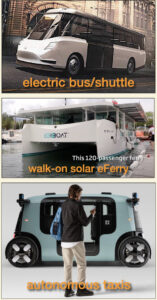 Popular with teens and seniors who are unable to drive. Imagine jumping on a shuttle to Cascade Lake with friends after school.
Popular with teens and seniors who are unable to drive. Imagine jumping on a shuttle to Cascade Lake with friends after school.- Supports family resource center low-income constituents who often struggle with the cost of car ownership – car, insurance, fuel. San Juan County’s low-wage tourist economy places it near the bottom of the working-wage barrel among Washington counties.
- Bainbridge and other communities are experimenting with on-demand public transportation for those that may be disabled or not near a main shuttle route.
- A new category of jobs for the county. Public transportation jobs typically pay a good living wage with benefits, including healthcare and savings plans.
Reducing drive-on ferry traffic may stimulate new modes of transportation in the county:
- Solar walk-on electric ferries are deploying around the world. During the sunny tourist season, they would be popular moving between the numerous public docks in town centers around the islands. As range and cost improve, routes could be added to Anacortes, Bellingham, Victoria, and Seattle. On cloudy days, the solar ferries could be backed up with high-speed charging at public docks.
- Uber/Lyft service would create a new class of flexible schedule jobs for locals while providing on-demand service for walk-on visitors. Grants may be available to create subsidies for drivers to incentivize the purchase of an EV for the service.
- Autonomous on-demand micro-transit is in development by companies like Zoox, targeting metro areas first, with testing underway in San Francisco, Seattle, and Las Vegas. We may eventually see these services here. They are similar to Uber/Lyft but driverless. Please take a look at the Notes below for more information.
- Bicycle paths along public rights-of-way to facilitate safer passage of local and visitor cyclists.
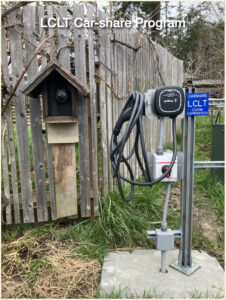 One final service, common on the mainland, is starting here in San Juan County – Car-Sharing. Lopez Community Land Trust (LCLT) was recently awarded a grant that covered the purchase of an EV, one year of insurance, and the administration of a car-sharing program. The project serves lower-income rural residents living in LCLT affordable housing neighborhoods. About 11% of the county’s population lives below the official poverty line. Car-sharing can help ease the cost of getting around.
One final service, common on the mainland, is starting here in San Juan County – Car-Sharing. Lopez Community Land Trust (LCLT) was recently awarded a grant that covered the purchase of an EV, one year of insurance, and the administration of a car-sharing program. The project serves lower-income rural residents living in LCLT affordable housing neighborhoods. About 11% of the county’s population lives below the official poverty line. Car-sharing can help ease the cost of getting around.
LCLT project goals include increasing accessibility, decreasing costs associated with individual car ownership, reducing the number of gas-powered vehicles in our neighborhoods, and reducing harmful carbon emissions. They purchased an EV with enough range to drive to Seattle and back without requiring a charge. The EV is currently shared among 12 people, with more in the works. The member cost is $60 per year and 20 cents per mile.
The Orcas Island OPAL community is also considering a Car-share program.
Transportation Poll
Here’s a brief one-question poll. After you take it, you will see what other readers have selected as their preferred island transportation options.
Thinking about future potential transportation options in the islands, which modes of transportation are you most likely to use?
Thank you! Please share this poll with other islanders.
Earthrise: A Climate Action Journal
This climate action journal offers information and actions we can take together, locally and globally, as we care for this precious Earth.
“The best way to heal a living system, is to connect it with more parts of itself.” ~ Margaret Wheatley
If you like what you read here, pass it forward to a few friends and ask them to do the same. Like a pebble tossed in a pond, the rings emanate outward, reflecting and growing exponentially. “Going exponential” is what it will take to reverse the climate extremes that are accelerating around us.
Thank you…
+ Get an alert when there’s a new Earthrise post: Notify Me!
+ Previous Earthrise posts:
• First Light • Robert Dash – photographer, educator, environmentalist • Extreme Rain • A Poem for the Snow Leopard •
• How the Chinese spy balloon can inspire climate action • Tidal energy in the Salish Sea •
• The biggest source of county greenhouse gas pollution •
Notes
The biggest source of county greenhouse gas pollution
Here’s a fantastic video showing visitors moving to, around, and from Nantucket on a Saturday in July.
Earth Day at The Odd Fellows Hall will discuss the Orkney Islands hydrogen ferry project.
Washington State Ferries (WSF) is embarking on an ambitious initiative to begin the transition to an emission-free fleet through a hybrid electric ferry system. WSF operates the largest ferry system in the United States. It is also the biggest contributor of greenhouse gas emissions of any state agency in Washington, burning 19 million gallons of diesel fuel to support 24 million passengers every year. Learn more.
Hydrogen-Powered Ferry for San Francisco
Process underway to construct a regional PNW hydrogen hub
Zoox Autonomous on-demand micro-transit
Puget Sound walk-on ferry study
If a county or town wants to establish a public transportation service, it can form a Transportation Benefit District (TBD). About 110 cities and towns in Washington haveTBDs, many of which are funded by sales taxes or vehicle license fees. TBDs can help unlock access to substantial federal and state public transportation funding. Anacortes is one example of a town that formed a TBD.
Example Transit Map: Salt Spring Island
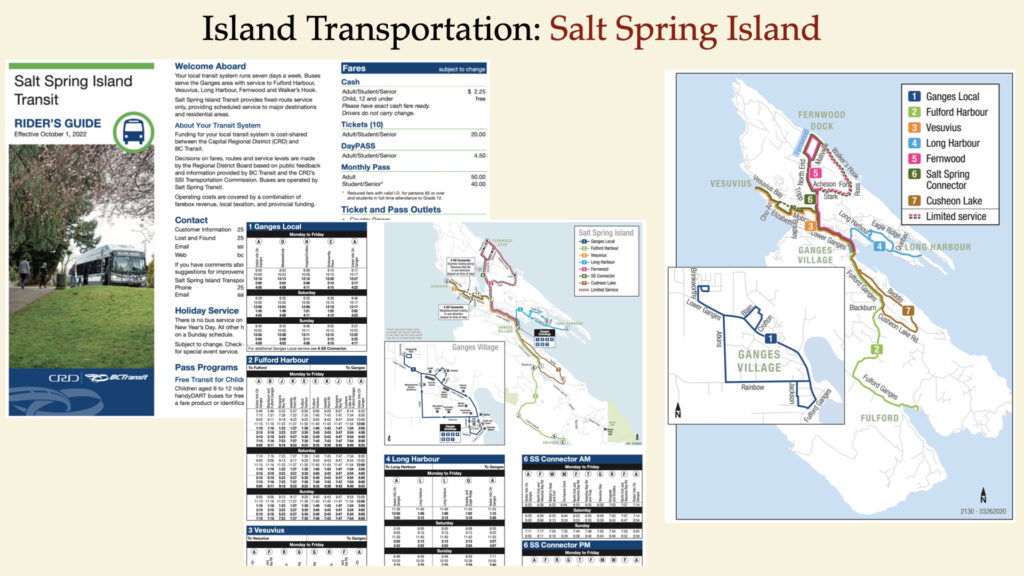
Tom Eversole, Orcas Island Senior Center Board President, posted a comment below with great data on Orcas Island seniors. This chart, prepared by Lynnette Wood, helps deepen our understanding of aging in place on Orcas.
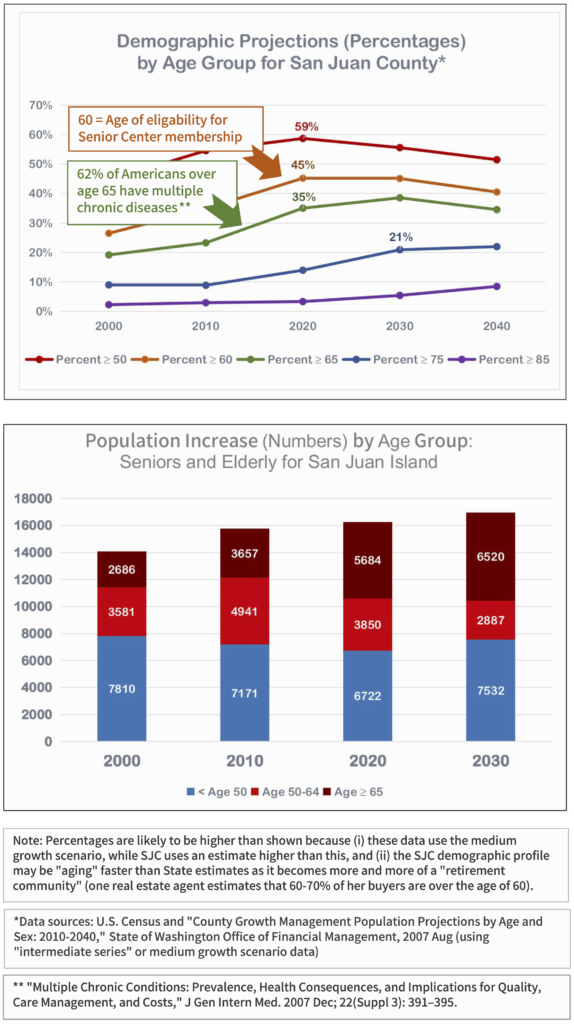
**If you are reading theOrcasonian for free, thank your fellow islanders. If you would like to support theOrcasonian CLICK HERE to set your modestly-priced, voluntary subscription. Otherwise, no worries; we’re happy to share with you.**






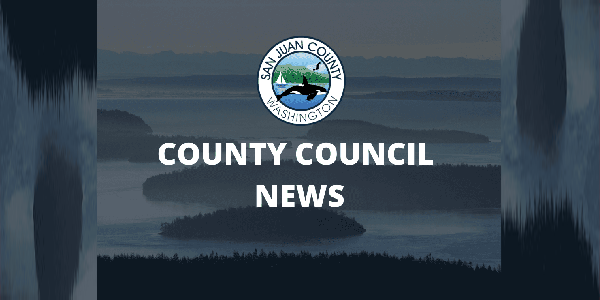


Jay,
You are amazing at presenting complex information clearly and completely.
I did not realise that the San Juan Islands have such a high proportion of seniors (like me).
The Transportation Overview Table shows how much we are lagging other island communities.
Thank-you!
An excellent précis, Jay. Thank you! Some comments-
One important difference between the islands named and San Juan County: the other islands are single, and can have unified transportation plans. This makes the ferry system an integral part of the County’s internal transportation system, not the case in the other examples.
And island shape makes a difference too. Nantucket is essentially linear. The Isle of Jersey (with a very comprehensive management plan) between England and France, is more compact, making many bus routes radiate like spokes from St. Hellier, the central town. Each of San Juan County’s islands is differently configured, requiring in each case a slightly different operating pattern.
This is to technology and society what shifting keys is to music. The optimum is when it all happens at once, thus the need to focus on equity, as you have done. Resilience for the few is not an option.
It is to be hoped (I haven’t checked), that the Climate and Sustainability Advisory Committee will look at transportation options in which the County could participate for the benefit of the low income segment, such as managing or contracting for management of EV (used?) car sharing. While this would be constitutionally permissible, the county may have to seek specific statutory authority for this activity. In passing, I hope that that committee assembles a wish list for authority to engage in the activities necessary to carry out a recommended program, and seriously lobbies that program with the Legislature.
Thanks again, Jay! Lots of good solutions there. Hopefully many will come to fruition—especially electric ferries!
I’m trying to understand the intent of your one-question transportation survey, which offers a choice between several non-exclusive, and in fact complementary, transportation options, both land- and marine- based. The whole idea of a multi-modal transportation system is connection; and that’s the only way it can work. Any idea of a foot-passenger ferry obviously depends on reliable land-side connections at both ends. So, yes to all: we need foot- passenger ferries, paratransit and bike lanes.
Another question to be asked is: who is being served? A land-side system serving tourists is likely to depend heavily on popular, fixed-route destinations while one serving year-round residents may have a more widely dispersed service area. This implies two-different, though complementary, modes.
Finally, as Bill Appel alludes to, the Islands’ geographical shape, roadway systems and, especially, settlement pattern need to be considered. One of the difficulties of planning a transportation system for San Juan County—as opposed to Bainbridge or even Nantucket—is our dispersed, rural settlement pattern and extensive network of private—and often dirt—roads. While a fixed-route system can efficiently serve nodes, the practical issue for most people would be getting from home to the bus stop. Efficient, cost-effective public transportation is one of the benefits of a town-centered (I’m avoiding the word urban) development pattern, but difficult in rural or suburban communities. We all know, from riding the ferry to getting there and back, that lifestyle choices also imply transportation choices and energy costs.
But to return to Jay’s point, we are beyond the curve compared to other island communities; and, as he shows, effective, energy-saving transportation can be done and it should be done.
Drive electric cars! That’s a huge thing we islanders can do to reduce greenhouse gas emissions on Orcas, especially since most of our power is hydroelectric. See OPALCO’s incentive on a charger.
I hope the author of this article adds this to his options.
Good presentation, Jay. Except for… I see NO mention of electric bikes! If the goal is to cut GHG emissions, ebikes can play a big part. But first we have to build the sorely needed infrastructure of bike lanes and paths that your transportation poll puts near the top of the list!
Thanks to all for the good discussion, ideas, and support.
Dan and Lynn – Electric bikes and cars! Yes! There seems to be good awareness of those, so my focus for this post was on public transit – systems that can carry many people, increase access equitably, and reduce GHGs in a big way.
Brian, the intent of the informal poll is to get a sense of what sorts of transportation solutions might interest the community. For a county with no conventional public transportation, the end goal might be “all of the above,” but the path to get there might be to start with one especially compelling thing. Test it out on one of the islands.
Bill, and Brian – Yes, as I said in the post, no “one size fits all” solution will serve our multi-island geography. For example, DOT data shows a strong walk-on contingent going to San Juan Island, where the town center and lodging are in close proximity to the ferry landing. For Orcas and Lopez, walk-on is minimal. It’s early days, with more questions and ideas than answers. Each island may end up having public transportation “tuned” to the specific needs of that single island. But we may find that certain solutions are universal. For example, there might be a free shuttle bus system, managed and funded under one umbrella, but with routes carefully designed to maximize access on each island. I added a map of Salt Spring’s Transit system in the Notes section above to show an example of how an island slightly more populated than San Juan Island, with a town center near the ferry, implemented its bus/shuttle system.
With strong community interest, the county has the ability to unlock substantial resources, experience, and funding at WashDOT.
One final thought. The transportation topic is immense. This post and the previous one are just two fractional peeks into the subject. More to come in the months ahead. But for now, gotta get ready for Earth Day!!!
The Center For Interdisciplinary Environmental Justice analysis says that electrification of cars in the United States will reduce national emissions by only 6 percent.
Paul Hawken doesn’t put electric cars in his top 10 climate solutions. It’s number 24 on his list, with almost ten times less impact than reducing food waste, nearly six times less impact than eliminating the use of refrigerants, and behind solutions like tropical rainforest restoration (about 5 times as effective at reducing emissions as is switching to EVs) and peatland protection (more than twice as effective).
Better solutions: women’s reproductive rights and education, economic relocalization initiatives, and demand-reduction initiatives.
If you need Earth Day posters, we have a bunch of great posters at Protect Thacker Pass: https://www.protectthackerpass.org/resources/
As Jay points out, the need for public transportation is acute for seniors on Orcas Island, especially to access off-island medical services. The article’s county-level data showing 37% of the county’s population being 60 or older may not accurately reflect the situation on Orcas or future trends.
In 2012, the Washington State Office of Financial Management’s Forecasting Division predicted that in 2020 more than half of Orcas Islanders would be 55 or older. Today, I think we could expect that to be true for 60-year-olds. Additionally, the 2036 San Juan County Comprehensive Plan Update (August, 2018) predicts that the only age group in San Juan County expected to increase over the next 15 years are those aged 75 and older. In other words, the need for public transportation for elders who may be less able to drive themselves will only increase.
Thank you, Jay, for this thoughtful and thought-provoking series! I am grateful for the good ideas folks are sharing and a movement toward consensus solutions.
Thanks, Tom, for the focused information on Orcas Seniors. We so appreciate the excellent work of the Orcas Senior Center. I posted the chart you sent me, in the Notes section above.
Thank you Jay for such a concise and understandable presentation. As mentioned by several commenters, we have the cleanest electrical source in the country and the easiest thing we can do to help reduce climate change is to electrify transportation, of every kind. Yes, globally refrigerant management is #1, but here in the Northwest, electrifying transportation will have a much greater affect than the 6% mentioned in the comments. We are fortunate, our electrical power is already decarbonized, we just need to take whatever burns fossil fuel and convert that to electric. For refrigerants, there are some climate- safe refrigerants being used in heat pumps and hot water heat pumps now and more coming in the next few years.